Most of my winter walks are brightened up by the usual suspects: woodpeckers, chickadees and nuthatches. So when I heard of another location not too far away that had some less common birds over-wintering, I decided to drive out to visit. The park is part of the Royal Botanical Gardens lands, if I understood the signage correctly, and some kind person (or persons) has created several bird feeding stations along the path that are greatly appreciated by the local creatures. And yes, on my wintery but bright walk through the woods, I did see some Rusty Blackbirds and two Tufted Titmice.
NOTE: After this article was posted I was informed via the Hamilton Bird Studies group that the paths are closed for nature regeneration. I will not visit them again.
Rusty Blackbirds Appreciate Scattered Seeds
There are no official paths that I could see at this location. Instead, dog walkers and nature enthusiasts had beaten down a rough trail through a goldenrod meadow and a second-growth forest. So I wasn’t sure exactly where I should be going but I ambled along noting landmarks and realizing I could easily see buildings to keep my bearings. A large pond bordered one side of the trail providing another orientation feature.
As I entered the woods, I noticed the first of several places where someone had spread a lavish amount of seeds and grain on the forest floor. The chickadees calling and flitting up and down to the seeds tipped me off so I slowed way down and stepped cautiously closer.
I’m glad I took my time, because a group of 5 skittish Rusty Blackbirds were enjoying the seeds. While, as usual for me, the light was in the wrong direction, I started taking photos. Fortunately, the sun came out briefly when the flock zipped up into the surrounding trees briefly. The Blackbirds fed again for another few minutes, then left towards the large pond.
Investigating Small Mammals Made an Interesting Opportunity
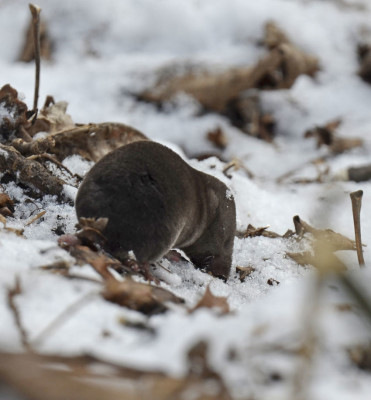
Possible Northern Short-tailed Shrew
Usually, the only small mammals I am privileged to see are Chipmunks, Red and Grey Squirrels. So I was quite pleased when I met something else this trip. I had noticed some dead leaves twitching near the seed pile and I focused on them, expecting a junco or sparrow to emerge. Instead, I saw a small, furry creature.
Dark grey, it zipped a few centimeters further over and dove headfirst under another pile of leaves. It repeated this fast-paced hunting for several minutes. I didn’t want to alert it to my presence, so I crept closer very slowly. Unfortunately, it wasn’t interested in posing or in resting, so at no time did I clearly see the entire animal. Usually, I was lucky to see its rump or a hind foot.
The creature was not interested in the seeds at all so I doubt it was a mouse. Its tail was also only about 3 cm long (1.2 inches) from what I could see.
Based on the “hunting” behaviour and the very fuzzy look I got at it, I suspect it was a Northern Short-tailed Shrew. I’d love to get a better look another day! However, based on some quick online reading at the Smithsonian website, it seems that these Shrews hunt frantically for about 5 minutes, then rest for about 25. If so, it would be almost impossible to predict when or where you might see one.
Later, at another feeder, I saw another small mammal. This one was more likely a mouse, although I am far from certain. I only saw it for a second, long enough for this one photo of its ear. Mice, which often eat seeds under feeders, should be easier to find a second time than a shrew, so I may get to see this one again on another visit.
The Feeders Attracted Lots of Common Winter Birds
Although the mammals and uncommon birds made this a memorable walk, I still enjoyed the chance to watch many other feathered feeders. Blue Jays, Northern Cardinals, Mourning Doves, White-throated and American Tree Sparrows, and Dark-eyed Juncos all mobbed the seeds. And overhead, a Red-tailed Hawk soared.
In fact, the Red-tailed called a few times in a row. For some reason, I just assumed it was a Blue Jay mimicking a hawk, but when I finally looked up, it was right over head. That should teach me to look closer when I hear a bird call.
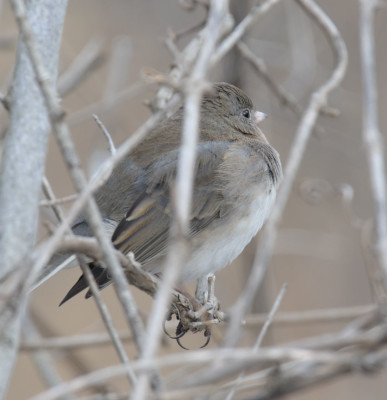
This Dark-eyed Junco is probably a female.
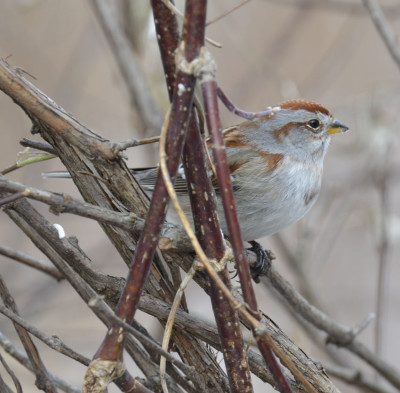
American Tree Sparrows with their two-coloured bills and rusty caps added some colour under the feeders.
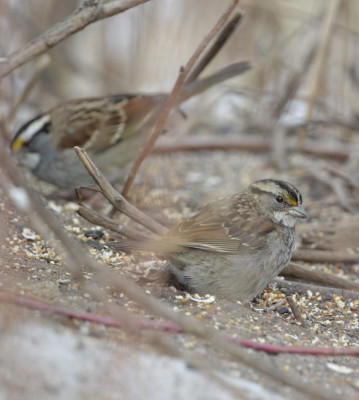
The White-throated Sparrows, though, added some song which was also appreciated.
Tufted Titmice Rival Shrews for High-Energy Food Hunting
I did see the pair of Tufted Titmice known to live in the park, too. They didn’t stay still long though. They visited two of the feeder stations, spaced quite far apart, while I was nearby watching sparrows. A Titmouse would fly in, snatch a snack, and then fly out. They didn’t linger the way the sparrows and juncos did. Chickadees also keep on the move but the Titmice made even them look relaxed.
I had a very pleasant time exploring this new-to-me area. I’m not sure I’d like it as much in the spring when it looks to get marshy, or in the summer, when it seems to be covered in dog-strangling vine, judging by the withered leaves. Still, it’s a great spot for a winter prowl!
Related Reading
Join In
Have you had any uncommon birds at your feeder this year? Or any small mammals visiting? Please share your sightings with a comment.

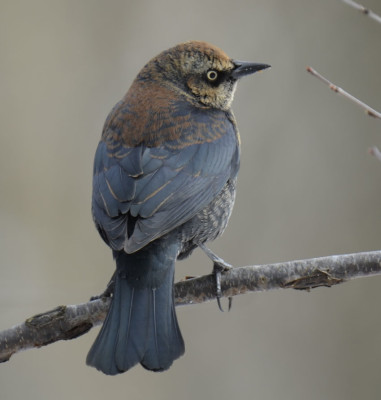
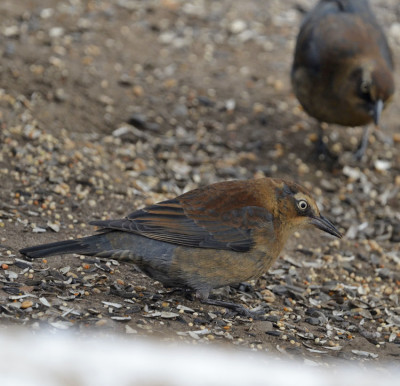
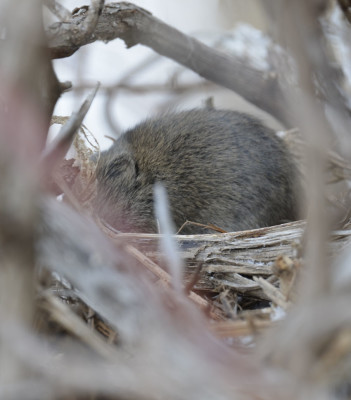


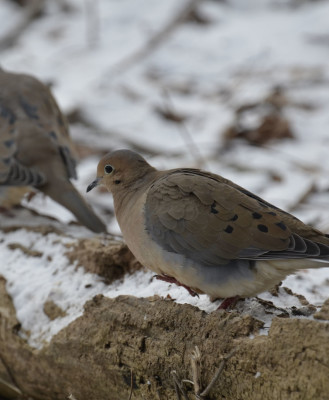
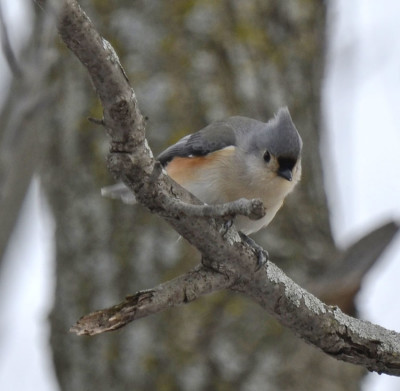
That second mammal is a Meadow Vole, generally the small mammal I see visiting feeders in the day. I’ve also seen Short-tailed Shrews under feeders a couple of times.
Thanks for the id! I’d like to get a longer look at both of these but small mammals can be pretty skittish.